Echinacea is an extract from a plant native to the prairies of North America which is taken as an herbal supplement to boost your immune system, protect your body from infection, and speed your recovery when you get sick.
It was used by Native Americans for hundreds of years for its medicinal properties, and clinical research has begun to explore the science behind its use as an immune system booster.
If you want a stronger immune system and greater protection against the common cold and other upper respiratory infections, echinacea might be the solution you’re looking for.
Our experts have reviewed and ranked the ten best echinacea supplements on the market.
Research
Rankings
1. NOW Echinacea
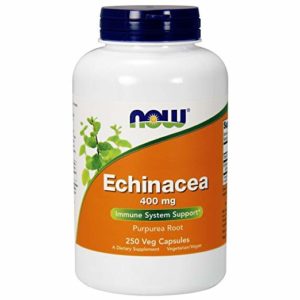
NOW Echinacea is a dead-simple way to boost your immune function. With 400 mg of echinacea plant material per cellulose capsule, this is a vegan-friendly and very pure supplement.
The only additional ingredient is a small amount of vegetable-derived stearic acid to hold the capsule together.
2. Puritan’s Pride Echinacea
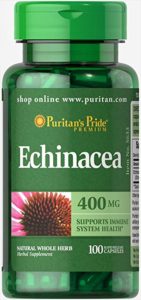
Puritan’s Pride Echinacea is about as pure as you can get. Each capsule has 400 mg of echinacea root extract in a gelatin capsule. The other ingredients? Absolutely nothing.
Though strict vegetarians and vegans won’t like the animal-derived gelatin, pretty much everyone else is going to have a very hard time finding anything wrong with this supplement.
3. Horbaach Echinacea
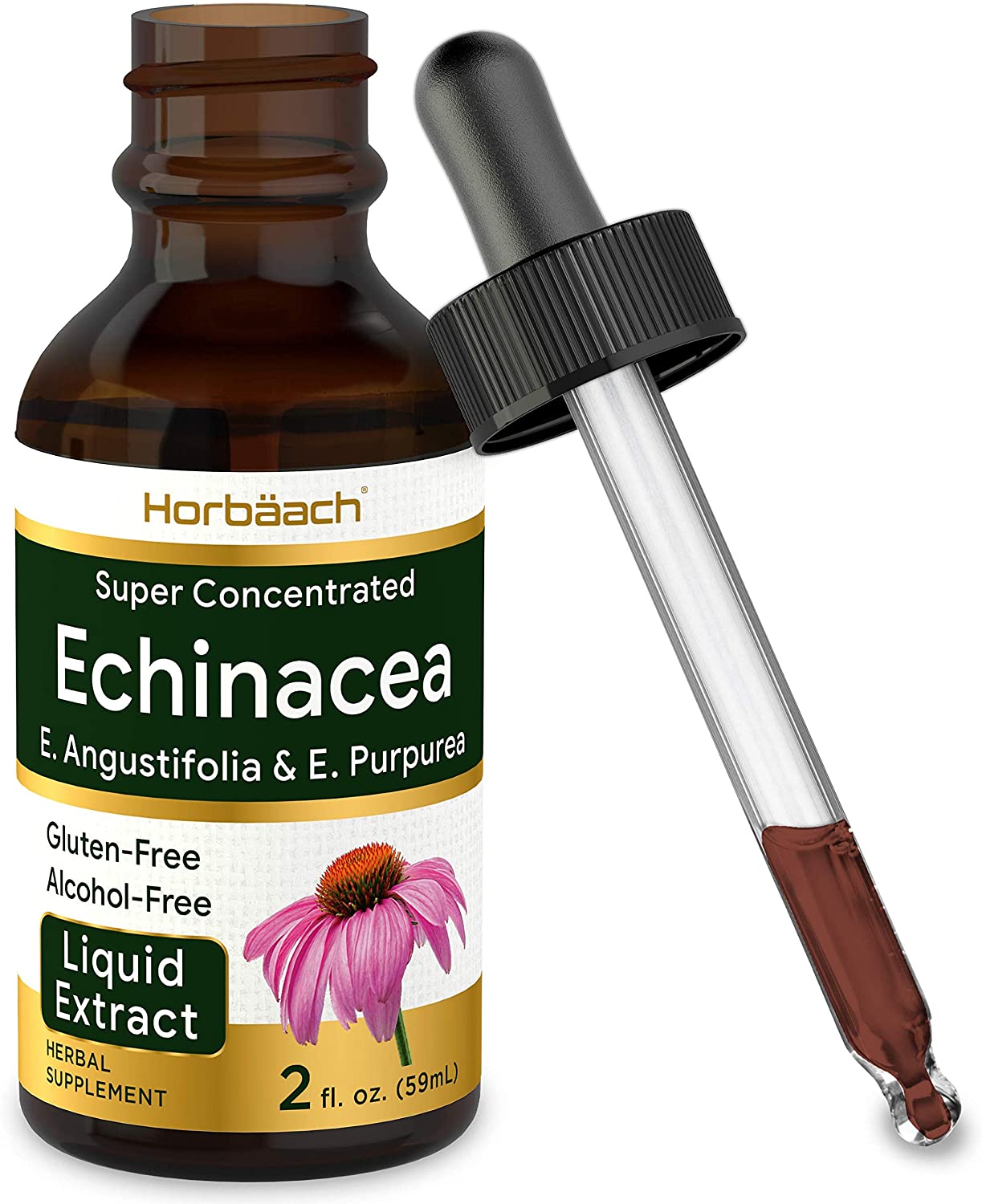
Horbaach makes an excellent liquid echinacea supplement that’s our recommended pick if you’re specifically looking for a liquid echinacea supplement. It can be taken on its own, or mixed into a hot beverage like tea (possibly with other soothing additives like manuka honey) to treat a cold or sore throat.
4. Herb Pharm Echinacea Immune Support
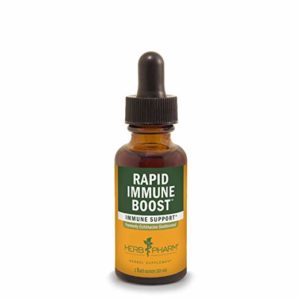
Herb Pharm Echinacea Immune Support is a liquid-form echinacea supplement that has the additional benefit of being certified organic.
When dealing with a raw extract from plant material, this is particularly attractive, as you don’t want pesticides or herbicides in a supplement like this.
While measuring out droplets isn’t going to give you as accurate of a dosage as you’d get in a capsule, this is still a solid pick for those who want a pure echinacea extract delivered as easily as possible.
5. Vitacost Echinacea

Vitacost Echinacea is the way to go if you want a higher dosage. At 600 mg of echinacea root extract per capsule, it’s head and shoulders above most other echinacea supplements.
Whether you actually need a dosage this high is less clear; according to the research, not everyone does.
6. Solaray Echinacea with Vitamin C and Zinc
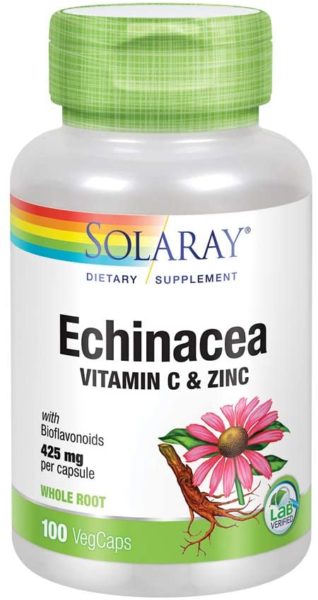
Solaray Echinacea with Vitamin C and Zinc attempts to deliver echinacea alongside a range of other compounds that boost immune function.
This includes, as the name suggests, vitamin C and zinc, which have both been studied for their ability to fight infections, but also rose hips, bioflavonoids, and hesperidin concentrate.
Whether these add much beyond the benefits of echinacea is unknown, but it might be worth a shot if usual echinacea supplements aren’t doing the trick for you.
7. Gaia Herbs Echinacea Supreme

Gaia Herbs Echinacea Supreme uses a proprietary blend of two different species of echinacea: echinacea purpurea (the usual type that’s included and has been tested in clinical research) and echinacea angustifolia, which is less well-studied.
The proprietary blend makes it hard to determine precise dosage, so following the clinically validated dosing programs is going to be more difficult with this supplement.
8. Nature’s Way Echinacea Goldenseal
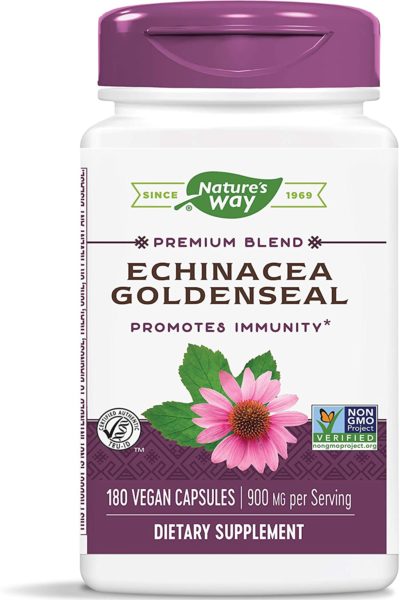
Nature’s Way Echinacea Goldenseal is an herbal combination of not just two, but seven different herbal compounds intended to boost your immune function.
This includes echinacea and goldenseal, as well as an echinacea relative, burdock, gentian, cayenne pepper, and wood betony.
The only issue with this strategy is that these ingredients are mixed together in a proprietary blend, so you can’t tell how much of each herb is included in the supplement, making dosing decisions difficult.
9. BioSchwartz Echinacea Complex
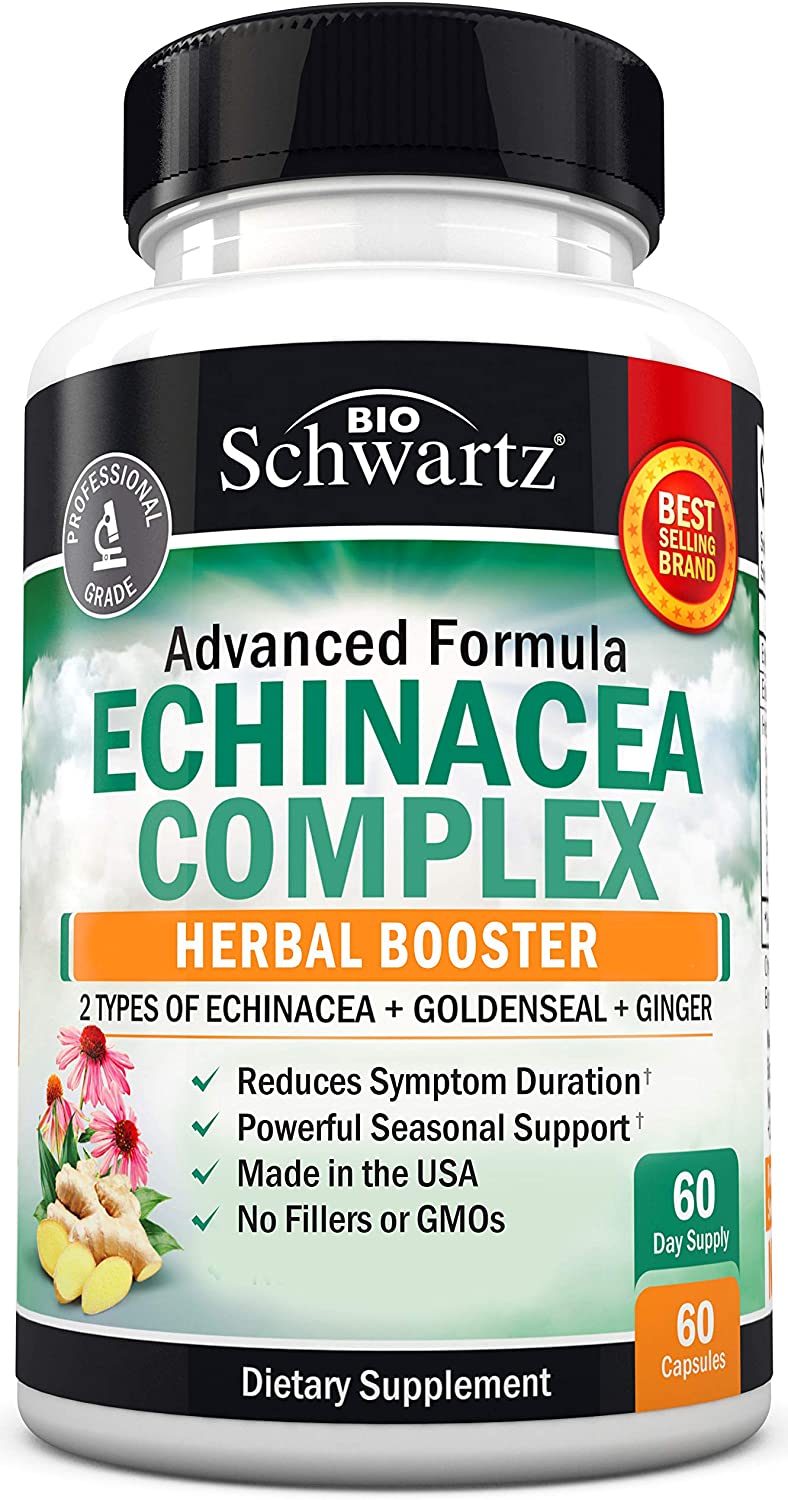
BioSchwartz Echinacea Complex combines echinacea with goldenseal, ginger, ginseng, and cayenne pepper, making it a decent multi-ingredient herbal supplement for immunity. However, many of these ingredients are bundled in a proprietary blend, making it difficult to tell the exact dosages.
10. Best Naturals Echinacea & Goldenseal Root
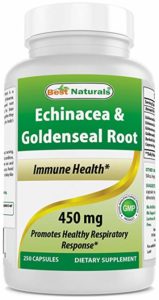
Best Naturals Echinacea & Goldenseal Root has the same herbal combination you’ll find in several other echinacea and goldenseal combinations (burdock and cayenne in addition to both species of echinacea).
However, the ingredients are not only obscured behind a proprietary blend; the actual dosage of this blend is not very high. Most people would be better-suited by a different supplement, even if they wanted a combined herbal formulation.
Who should buy echinacea?
Echinacea is safe for most people and is great for boosting the immune system and help to reduce the severity and length of colds. Echinacea may also help reduce anxiety in certain people.
People with autoimmune disorders should not take echinacea. If you are infected with HIV, AIDS, or tuberculosis, you should also avoid echinacea as it may negatively affect your situation. Since echinacea can alter how some medications are metabolized in the body, it’s important to speak to your doctor before starting a supplement regimen with echinacea.
Category winners
Best echinacea overall: NOW Echinacea
NOW Echinacea has a solid dosage, vegan-friendly capsule, and an extremely minimal ingredients list. If you’re looking to harness the power of echinacea, there’s no better all-around pick, which is why it’s our top recommendation.
Best echinacea for the common cold: NOW Echinacea
If you’re looking for an echinacea supplement to take at the first sign of a cold, NOW Echinacea is the way to go. The dosage is high and there’s nothing in the way of extraneous ingredients, meaning it’s rapidly absorbed and starts working to boost immunity right away.
Best echinacea with vitamin C: Solaray Echinacea with Vitamin C and Zinc
Solaray combines the immunity-boosting effects of echinacea alongside two other popular immune-boosting supplements, namely vitamin C and zinc. This trifecta makes it our favorite source of echinacea plus vitamin C.
Best echinacea for boosting immunity: NOW Echinacea
NOW Echinacea is also our favorite when it comes to overall immunity enhancement. If the history of echinacea as an herbal remedy appeals to you, you’re probably looking for an echinacea supplement that’s as pure as possible, and NOW fits the bill.
Best best liquid echinacea: Horbaach Echinacea
In traditional preparations, echinacea is often taken as a liquid extract, and Horbaach Echinacea is the best option on the market. It’s pure, alcohol-free, and delivers a fast-acting dose of echinacea that can be taken on its own or combined with tea.
Best echinacea for a sore throat: Solaray Echinacea with Vitamin C and Zinc
Both echinacea and zinc can be helpful for a sore throat, and vitamin C is a general-purpose immunity booster, so Solaray is a strong choice if you are looking for a supplement that’s particularly well-suited for the task.
How we ranked
Echinacea comes in a wide range of varieties, including Echinacea Angustifolia, Echinacea pallida, and Echinacea purpurea. We decided to primarily include products that are made from Echinacea purpurea since research has shown it to be the most effective.
Proprietary blends, like Best Natural’s and Nature’s Way, were ranked fairly low on our list as we weren’t able to determine the amount of echinacea used. Gaia Herbs ranked fairly well, despite being a proprietary blend, because it used a combination of two different Echinacea strains for maximum effectiveness: Echinacea purpurea and Echinacea angustifolia.
Another important factor we considered was manufacturing standards and dosing. In general, we preferred capsule-based products, like Vitacost, as it made for easier dosing. We did make an exception for Herb Pharm’s liquid-form echinacea supplement because it came from certified organic raw plant extract. However, it didn’t make the top 2 since it was difficult to accurately dose.
Lastly, we looked at the added ingredients. There are many other immune-boosting ingredients out there, such as vitamin C and zinc. Products that went the extra mile, like Solray, and included these ingredients alongside high-quality echinacea, were rewarded – as long as it didn’t take away from proper echinacea dosing. That being said, we did prefer pure echinacea products for this ranking, which is why Now and Puritan’s Pride took the top spots on our list. Now Echinacea took the #1 spot because it used a cellulose capsule instead of a gelatin-based one.
Benefits
Echinacea has a long history of use as a therapeutic agent to improve immune system function. Its active ingredients appear to modulate immune activity in your body, which could result in protection from infections like the common cold, and a more rapid recovery after getting sick.
Echinacea is sometimes combined with other supplements that also boost immune function, like zinc and vitamin C. Is echinacea worth adding to the list of supplements to take when you are sick? We’ll look at the scientific research.
According to the CDC, the average adult gets approximately two to three colds a year and kids get sick even more (1). While there is no cure for a cold, many rely on echinacea to prevent or help shorten the duration of symptoms.
There has been much debate about whether or not this herb makes a difference. Clinical trials are split; some show echinacea’s remarkable recovery rates and others reveal very little to no effect at all.
There appears to be a positive effect of echinacea on sickness frequency and in accelerating the rate of recovery; however, researchers stress that the effect size is not large and these claims are highly variable.
Some attribute this inconsistency due to the use of different plant species, extraction methods and the addition of other components (2).
Studies show echinacea’s benefit in decreasing the incidence and duration of the common cold. A 2007 meta-analysis evaluated the effect of echinacea on the incidence and duration of the common cold. Fourteen studies were included in the meta-analysis. Overall, it was assessed that echinacea decreased the odds of developing the common cold by 58 percent and the duration of a cold by 1.4 days (3).
In another meta-analysis, researchers found that the likelihood of experiencing a cold was 55 percent higher with placebo than with Echinacea (4).
In a 2006 review, published in The Cochrane Database of Systemic Reviews, researchers set out to investigate whether there is evidence that echinacea preparations are: more effective than no treatment; more effective than placebo; and similarly effective to other treatments in the prevention and the treatment of the common cold.
Three comparisons investigated the prevention of colds and 19 comparisons tested echinacea’s treatment of colds. A variety of different echinacea preparations were used.
The results of their analysis revealed that none of the three comparisons in the prevention trials showed an effect over placebo.
When comparing an echinacea preparation with placebo as treatment, a significant effect was reported in nine comparisons, a trend in one, and no difference in six (5).
Echinacea helps to reduce duration of symptoms in adults. A 2001 randomized, double-blind, placebo-controlled clinical trial was performed on 80 men and women showing the first signs of a cold.
In those treated with echinacea purpurea herb, the median time of illness was six days compared to nine days in the placebo group. It was also well tolerated in the participants (6).
Echinacea was not, however, effective in treating upper respiratory tract infections in children. Healthy children two to 11 years old were recruited and randomized to take either echinacea or placebo for up to three upper respiratory tract infections over a four-month period.
Studies were begun at the onset of symptoms and continued throughout the upper respiratory tract infection, for a maximum of 10 days.
Results showed that there was no difference in the overall estimate of severity of upper respiratory tract infection symptoms between the two treatment groups.
In addition, there were no significant differences between the two groups for peak severity of symptoms, number of days of peak symptoms or number of days of fever (7).
Rash occurred during 7.1 percent of the infections treated with echinacea and 2.7 percent of those treated with placebo.
Other studies produced equally conflicting results. A 2005 study published in The New England Journal of Medicine indicated that extracts of echinacea angustifolia root, either alone or in combination, did not have significant effects on rhinovirus infection (8).
On the other hand, a 2004 study using another echinacea composition — purpurea (2.5 mL three times per day, for seven days before and seven days after intranasal inoculation with rhinovirus type 39) — to evaluate its ability prevent infection with rhinovirus showed promising results.
Colds developed at a rate of 82 percent in placebo recipients and only 58 percent in those given echinacea purpurea (9).
Echinacea has been shown to reduce anxiety. Twenty-two healthy adults scoring high on the State-Trait Anxiety Inventory (STAI) were give one or two tablets a day (20 mg each) of Echinacea angustifolia extract for seven days.
The group taking two tablets a day (40 mg) reported decreased STAI scores within three days. The effects remained for the duration of the seven-day treatment and for the two weeks that followed treatment.
The lower dose (20 mg) did not affect anxiety significantly (10).
Essential oils from extracts of Echinacea purpurea have anti-inflammatory effects. The anti-inflammatory potential was evaluated in vivo by using different animal models with three serial dosages used: low, medium and high dosage.
All three dosages of extracts produced inhibitions of 39 percent, 47 percent and 45 percent respectively in the ear edema induced by xylene when compare with the control group.
Only the high dosage group showed statistically significant inhibition (49 percent) of paw edema compared with the control group; Moreover, the granulation formation (area of inflammation in tissue) model was also significantly reduced the most (by 29 percent) in the high dose group compared with the control group (11,12).
Side effects
There are generally no adverse effects of echinacea supplementation. There is, however, a correlation between an allergy to ragweed and echinacea. Therefore, those with a known allergy to ragweed may experience such side effects as dry eyes, hives and rash.
Other side effects may include headache, dizziness, nausea, constipation and mild stomach pain (13).
There have been isolated case reports of serious side effects, including severe acute hepatitis in a 45-year-old man linked to the ingestion of daily high doses of echinacea; Severe thrombotic thrombocytopenic purpura (a rare, serious blood disease) in a 32-year-old male following ingestion of echinacea to alleviate upper respiratory tract infection symptoms; and Asymptomatic leukopenia (decrease in white blood cell) in a 51-year-old woman following chronic use of echinacea (14).
Recommended dosage
The proper dosage depends on the species of echinacea being used as well as the form: liquid or capsules.
Echinacea purpurea in dehydrated powder (capsule form) is taken in doses of 300mg three time a day as well as 500mg three times a day.
Liquid forms of ethanolic extract leaves and stems are used in the concentration of 2.5mL three times a day or up to 10mL a day.
FAQ
Where does Echinacea come from? Echinacea, surprisingly, has ten species. These species are often called coneflowers, which are found in eastern and central North America, primarily within the United States. The states in which they are found include Ohio, Michigan, Iowa, Louisiana, and Georgia. It is also found in some parts of Canada, including the Rocky Mountains.
What parts of the Echinacea plant are used for supplement or medicinal purposes? The roots, flowers, and petals are all used to create capsules, teas, extracts, tablets, juices, or topical applications.
Who discovered Echinacea? Echinacea was originally first used by various indigenous groups in North America. In the late 1800s, John Uri Lloyd, an American pharmacist, began using it in the mainstream. From there, many other doctors and health professionals began recommending it for use to help certain health conditions.
Which types of people should not take an Echinacea supplement? Echinacea should not be taken if you have an autoimmune disorder, multiple sclerosis, HIV, AIDS, or tuberculous. It may also interact with certain medications, such as immunosuppressants. Before beginning to take any supplement or herb, discuss your options with your family physician. Some other medications or chronic conditions may also not interact well with Echinacea.
Can Echinacea help with the flu? Echinacea is widely encouraged to take when you have the flu. This is due to its impact on the immune system, which may decrease the symptoms of the flu.
Will Echinacea keep me awake? One of the rare side effects of taking Echinacea is insomnia. If you begin experiencing trouble sleeping after beginning to take this supplement, consider lowering the dose or halting consumption altogether. Discussing your options with your family physician may also help you determine if anything else is causing you sleeping problems.
Can Echinacea cause headaches? Echinacea has caused headaches in some individuals. It is also one of the rare and few side effects of this supplement. In particular, taking Echinacea along with caffeine may result in not just a headache, but shaking and a quickened heart rate.
Can Echinacea cause rashes? Echinacea may cause a rash in the case of an allergic reaction. Along with a rash, someone may experience difficulty breathing and swelling. If a rash occurs, stop taking Echinacea immediately. If any symptoms, such as difficulty breathing, also occur, seek our immediate medical attention.
Can Echinacea be taken with paracetamol? Paracetamol, also known as acetaminophen, may interact with Echinacea. Since Echinacea increases blood volume, it may increase the effects of paracetamol. As such, you may need to take a lesser dosage. It also may be a good idea to talk with your doctor or local pharmacists if you have any concerns about these compounds and their interactions.
Can Echinacea help with a cold? In the same way that Echinacea helps with the flu, it can also help reduce symptoms associated with the common cold. However, many of the studies involving Echinacea tend to have a high amount of biases involved, such as being sponsored by a drug company that manufactures this type of supplement. Thus, more research is required to determine exactly how and if Echinacea can help fight the common cold and flu.
Which Echinacea plant is best for medicinal use? Echinacea Angustifolia, a narrow-leaved flower, is traditionally used to help boost the immune system. However, sometimes Echinacea purpurea, a pale purple coneflower, is used. Yet, this type of Echinacea is thought to be less effective than the other and more popular type. In fact, it’s been speculated that to take Echinacea purpurea and to have the same effects as Echinacea Angustifolia, a person would actually have to take more of it.
Can you take Echinacea when pregnant or breastfeeding? Various sources suggest that Echinacea is safe to take when pregnant or breastfeeding. However, due to the lack of proof and published studies on this particular supplement and plant, many physicians and health experts recommend avoiding taking it if you are pregnant or breastfeeding.
How does Echinacea work? As previously mentioned, studies have been mixed in regards to this particular plant and its uses. However, research has shown that Echinacea can increase white blood cell count in mice (15).
This may indicate why Echinacea is used for helping to fight the common cold and flu. It may help increase your immune response, thus helping you fight off foreign cells, bacteria, or germs much quicker. Echinacea may also help decrease inflammation in the body by stimulating and activating certain compounds and chemicals. It may further attack any yeast or fungi present in the body.
How much Echinacea should I take? The manufacturers of Echinacea in its supplement form may recommend various dosages. Often, it is best to read the label of the specific product you have purchased. Many products state to take one to two capsules two to four times per day. In dry powder form, this may equate to 300 to 500 mg three times per day. In liquid form, this may equal 2.5 ml three times per day.
Is Echinacea poisonous for cats? Surprisingly, Echinacea isn’t poisonous for cats. In fact, it may actually support your cat’s immune system, including if they were to experience an upper respiratory tract infection. However, always talk to your pet’s vet before administering any supplement to your cat.
Is Echinacea toxic for dogs? Echinacea is not toxic for dogs. In powder form at about 45 mg per pound of body weight, it can actually help treat dogs when it comes to upper respiratory tract infections. Again, it is always a wise idea to discuss your options with your vet’s pet before giving your dog any herb or supplement.
Who sells Echinacea? Echinacea can be found at most pharmacies, some bigger department stores like Walmart, some grocery stores, health food or supplement stores, and online. Wherever you buy your Echinacea from, ensure you always read the label carefully before consuming it.
Who can take Echinacea? Echinacea is considered safe for most people when taken in the short-term (less than 14 days). Some products have shown to be safe for use up to 6 months as well. Individuals who are pregnant, breastfeeding, have allergic tendencies, or autoimmune disorders should not consume Echinacea.
Can Echinacea help with eczema? Interestingly, Echinacea may contribute to reducing eczema symptoms, specifically for more mild cases. However, it may take about 12 weeks for the topical application of Echinacea to show improvements in redness, swelling, dryness, and itchiness.
Can Echinacea help improve athletic performance? Yes, Echinacea may help improve your athletic performance to a certain extent. Some research has shown increased oxygen intake in athletes that took Echinacea for 28 days.
Can I drink coffee when taking Echinacea? This is something you may want to be careful with. Echinacea may alter how quickly the body is able to metabolize and break down the caffeine in coffee. These may lead to increased effects of the coffee, such as a quickened heart rate, shakiness, and even headaches. We recommend taking Echinacea many hours after you have had coffee, and recommend that you try not to combine the two.
What forms is Echinacea found in? You can buy Echinacea in tablet form, as well as juice or tea form.
Can Echinacea help with anxiety? At a dosage of 40 mg per day, Echinacea may help reduce anxiety in certain individuals.
Can Echinacea contribute to better oral health? Maybe. Echinacea has been mixed with Gotu kola and elderberry as a mouth rinse. When used in this way, it is thought to prevent gum disease.
Can I grow my own Echinacea? Surprisingly, Echinacea is considered an endangered plant. This means that growing your own Echinacea is actually preferred to picking it from any spot in the wild.
How can I grow my own Echinacea? To grow your own Echinacea, all you need is a seed and a place to grow it. Typically, these seeds germinate after about 10 or 20 days. For use, you can then either make an infusion with the leaves and petals or dry it and use it as a tea or capsule.
How long should I take Echinacea for? The most common answer to this question comes from various experts saying to avoid taking Echinacea for longer than eight weeks. However, there is no evidence indicating any dangers or harm in taking it past the eight-week mark. Generally, there is not much evidence regarding the long-term use of Echinacea.
Will the Echinacea plant flower within its first year? Yes, if it is cared for and grown as instructed, you should see flowers blooming on your Echinacea plant in the first year. You can then use these petals for your own health uses.
Can Echinacea cause itching? For some individuals with allergic tendencies, Echinacea may cause itchiness, as well as redness or a rash. If you are prone to allergies, it is not recommended to consume Echinacea.
Will Echinacea help with tonsillitis? There is some evidence indicating that Echinacea may help with tonsillitis. In the same way it helps with the flu and the common cold, Echinacea may help increase white blood cells and decrease inflammation.
Related Articles
- Immune system supplements
- Elderberry syrup
- Vitamin C
- Zinc
- Vitamin D
- Multivitamin for men
- Multivitamin for women
Recap
Echinacea is an herb that has long been taken to prevent and treat the common cold. Clinical studies show conflicting information on its efficacy. There is some evidence that certain preparations of echinacea species might be effective for the early treatment of colds in adults but results are not fully consistent.
Some attribute this inconsistency due to the use of different plant species, extraction methods and the addition of other components.
Further clinical studies are required to confirm which echinacea preparations are most effective and in what form. Some studies also show echinacea’s promising anti-inflammation and anti-anxiety effects.
For BodyNutrition’s #1 recommended echinacea supplement, click here.